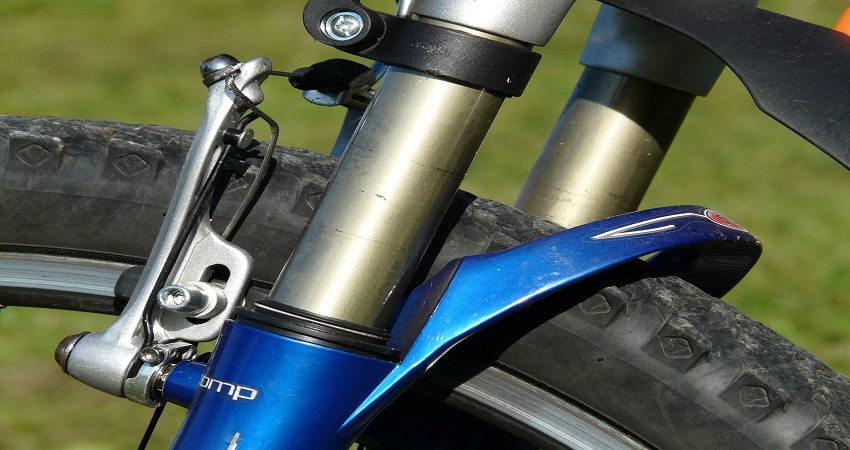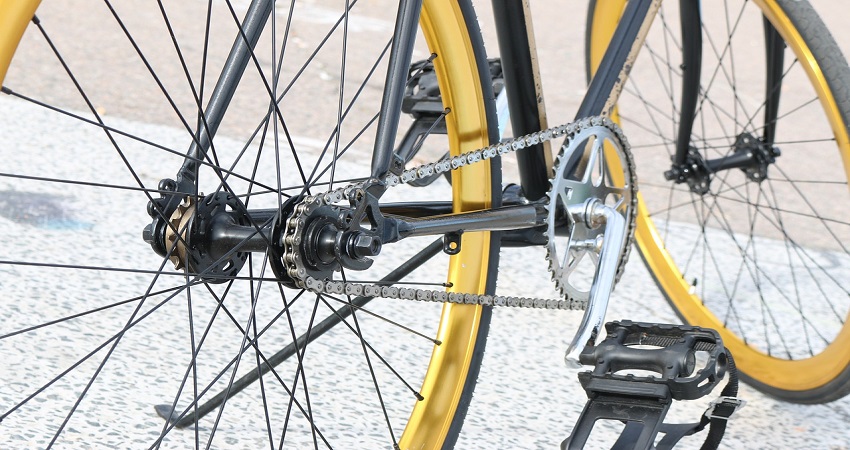Tapered forks have a gradually reducing diameter, usually from top to bottom, while non-tapered forks have a consistent diameter throughout. Tapered forks offer increased stiffness and steering precision, especially during high-speed rides and aggressive maneuvers.
They also improve overall bike handling and control. Non-tapered forks, on the other hand, are generally lighter and less expensive. However, they may sacrifice some stability and responsiveness compared to tapered forks. When choosing between tapered and non-tapered forks, it’s essential to consider your riding style, terrain, and personal preferences to ensure optimal performance and compatibility with your bike.
So, let’s explore the key differences between these two fork types in more detail.
Tapered Forks
Tapered forks are a common feature in modern bikes, designed specifically to improve stability and steering. Unlike non-tapered forks, which have a consistent diameter from top to bottom, tapered forks gradually reduce in diameter towards the top. This design variation offers several advantages that make tapered forks a popular choice among cyclists.
Design And Construction
The design and construction of tapered forks play a crucial role in their performance. These forks feature a larger diameter at the bottom, where they connect to the frame’s head tube, gradually tapering down to a smaller diameter at the top where the stem attaches. This design helps distribute forces and stresses more evenly along the fork, enhancing durability and stiffness.
Enhanced Stability And Steering
Tapered forks significantly improve stability and steering responsiveness compared to non-tapered forks. The wider diameter at the bottom provides increased surface area for the fork to connect with the frame, resulting in improved grip and control during cornering and rough terrains. This wider bottom section also improves the overall stiffness of the front end, enhancing the bike’s handling capabilities.
Compatibility And Interchangeability
Tapered forks offer greater compatibility and interchangeability with various bike components. Many modern bike frames are designed specifically to accommodate tapered forks, making it easier for cyclists to upgrade or replace their forks without facing compatibility issues. Additionally, tapered forks are often compatible with both straight and tapered steerer tubes, providing flexibility in setup options and allowing cyclists to choose the fork that best suits their needs.
In summary, tapered forks have a unique design and construction that enhances stability and steering, providing improved control and handling on different terrains. Their compatibility and interchangeability make them a versatile option for cyclists looking to upgrade or replace their forks.
Non-tapered Forks
When it comes to choosing the right fork for your bike, understanding the differences between tapered and non-tapered forks is essential. In this article, we will focus on non-tapered forks, exploring their design and construction, standardized size and fit, as well as their cost and availability.
Design And Construction
Non-tapered forks feature a consistent diameter throughout their length, providing a uniform appearance and reliable performance. These forks are typically made from a single piece of material, such as aluminum or carbon fiber, which enhances their strength and stiffness. The absence of a tapered design means that non-tapered forks do not gradually increase in diameter towards the bottom, resulting in a slightly heavier overall weight compared to tapered forks.
Standardized Size And Fit
One advantage of non-tapered forks is their compatibility with a wide range of bike frames and headsets. These forks often come in standardized sizes, making it easier for riders to find a suitable option for their specific bike model. Whether you have a mountain bike, road bike, or hybrid, non-tapered forks can typically be fitted without any compatibility issues, ensuring a hassle-free installation process.
Cost And Availability
In terms of cost and availability, non-tapered forks often offer a more affordable option compared to their tapered counterparts. Since they have been the standard for many years, non-tapered forks are widely available in various price ranges, making them accessible to a larger audience. Additionally, their compatibility across different bike types means that riders have more choices when it comes to selecting a non-tapered fork within their budget.
Overall, non-tapered forks are a dependable choice for riders seeking a reliable fork design that offers compatibility, ease of installation, and affordability. Whether you are a novice cyclist or an experienced rider, considering the benefits of non-tapered forks will help you make an informed decision for your bike.
Factors To Consider
Tapered and non-tapered forks differ in their shape, affecting a bike’s steering and stability. Tapered forks gradually change in diameter, providing better handling and stiffness, while non-tapered forks have a consistent diameter throughout. Factors to consider include riding style, terrain, and personal preferences.
Riding Style And Terrain
Your riding style and the terrain you plan to tackle are important factors to consider when choosing between tapered and non-tapered forks. Tapered forks, which have a larger diameter at the bottom where it connects to the crown race, offer increased stiffness and stability, making them ideal for aggressive riding styles and rough terrains. The larger diameter provides better tracking and control, allowing you to confidently tackle challenging trails and descents. For riders who enjoy blasting through technical sections or hitting jumps, a tapered fork is often the preferred choice.
On the other hand, non-tapered forks, also known as straight forks or 1 1/8″ forks, are lighter and more suited for smoother terrains and recreational riding. They are commonly found on road bikes and lightweight mountain bikes. While they may lack the same stiffness as tapered forks, they offer a more forgiving ride that absorbs road or trail vibrations, enhancing comfort over longer distances. Non-tapered forks are also easier to maintain and find replacement parts for, making them a cost-effective option for budget-conscious riders.
Bike Frame Compatibility
Another factor to consider when choosing between tapered and non-tapered forks is bike frame compatibility. Tapered forks are designed to fit frames with tapered head tubes, which have a larger diameter at the bottom than at the top. This design enhances the overall stiffness of the frame and fork combination, improving handling and control. If you have a frame with a tapered head tube, opting for a tapered fork ensures a seamless integration and maximizes performance.
On the other hand, if your bike frame has a non-tapered head tube, a non-tapered fork is the appropriate choice. Trying to fit a tapered fork on a non-tapered head tube could result in compatibility issues and compromise the overall performance of your bike. It’s important to match the fork to the frame specifications to ensure a proper fit and optimal riding experience.
Budget And Accessibility
Finally, budget and accessibility are key factors to consider when deciding between tapered and non-tapered forks. Tapered forks, being the more advanced and high-performance option, tend to come with a higher price tag. The larger diameter and increased technology in tapered forks contribute to their superior stiffness and performance, but this can make them costlier than non-tapered forks.
Additionally, non-tapered forks are typically more easily accessible and available in a wider range of options, making them more budget-friendly. They are a popular choice for entry-level and recreational riders who may not require the added stiffness and performance advantages of tapered forks. If your budget is limited or if you are a casual rider, choosing a non-tapered fork can be a sensible and economical choice.
Choosing The Right Fork
When it comes to selecting the perfect fork for your bicycle, understanding the difference between tapered and non-tapered forks is crucial. This decision plays a significant role in the overall performance, handling, compatibility, and personal preference of your bike. In this article, we will delve into the key factors to consider when making this choice.
Performance And Handling
One of the most important considerations when choosing a fork is its impact on performance and handling. Tapered forks, as the name suggests, have a gradual change in diameter from top to bottom. The wider upper section provides enhanced stiffness, ensuring precise steering and control during intense riding conditions. On the other hand, non-tapered forks have a consistent diameter throughout their length, leading to a slightly different riding experience. They tend to offer a more compliant ride, absorbing small vibrations and shocks on the road or trail.
For riders seeking a more aggressive and responsive feel, a tapered fork is often the preferred choice. Its increased stiffness translates into improved power transfer and cornering stability, especially during high-speed descents or technical maneuvers. However, if comfort and smoothness are higher priorities, a non-tapered fork may provide a more forgiving ride, making it ideal for long-distance or endurance rides.
Compatibility And Interchangeability
Compatibility and interchangeability are crucial factors to consider when selecting a fork. Tapered and non-tapered forks have different steerer tube diameters, which means they require specific frames or adapters. Tapered forks usually have a 1.5-inch bottom diameter and a 1 1/8-inch top diameter, while non-tapered forks typically have a consistent 1 1/8-inch diameter. It’s essential to ensure that your frame is designed to accommodate the specific fork you choose.
There are cases where you may want to change your fork or switch between tapered and non-tapered options. In such instances, it’s important to carefully check compatibility and seek guidance from professionals or bike manufacturers to ensure a seamless fit and optimal performance.
Personal Preference
As with any component in cycling, personal preference plays a significant role in selecting the right fork. While performance and compatibility are essential, choosing a fork that aligns with your individual riding style, goals, and comfort level is crucial. Some riders value the stiffness and control of a tapered fork, while others prioritize the smoothness and compliance of a non-tapered fork.
It’s important to consider your own riding characteristics and preferences before making a decision. Try out different forks if possible, seek advice from experienced riders, and consider the terrain and riding conditions you most commonly encounter. Remember, the perfect fork is the one that enhances your riding experience and gives you confidence on the bike.
Frequently Asked Questions For What Is The Difference Between Tapered And Non-tapered Forks?
What Is A Tapered Fork And How Does It Differ From A Non-tapered Fork?
A tapered fork refers to a bike fork that has a larger diameter at the bottom where it connects to the frame and a smaller diameter at the top where it connects to the handlebars. This design provides better handling, stiffness, and control, especially during intense rides and off-road conditions.
In contrast, a non-tapered fork has a consistent diameter throughout its length, offering less stability and responsiveness.
Why Should I Choose A Tapered Fork Over A Non-tapered Fork?
Opting for a tapered fork offers several advantages. Firstly, the larger diameter at the bottom enhances torsional stiffness, resulting in better control when cornering or descending. Secondly, a tapered fork creates a stronger and stiffer connection between the frame and the handlebars, enhancing overall stability and steering precision.
Lastly, this design allows for weight reduction without compromising strength, resulting in a lighter and more efficient ride.
Can I Use A Tapered Fork On A Frame Designed For A Non-tapered Fork?
No, it is not possible to use a tapered fork on a frame designed for a non-tapered fork. The dimensions and specifications of the frame and the fork need to match for proper compatibility. Using an incompatible fork can lead to poor performance, compromised handling, and potential safety risks.
Always consult your bike manufacturer or a professional bike mechanic to ensure you choose the correct fork for your frame.
Conclusion
To summarize, understanding the difference between tapered and non-tapered forks is crucial for any cyclist. Tapered forks provide enhanced stiffness and control, making them ideal for high-speed, demanding rides. On the other hand, non-tapered forks offer a cost-effective option for riders seeking a more comfortable and forgiving ride.
Ultimately, choosing the right fork depends on your specific needs and riding style. So, whether you’re a professional racer or a casual cyclist, carefully consider these factors to make the best decision for your bike.



